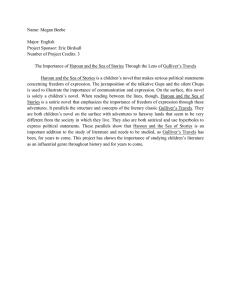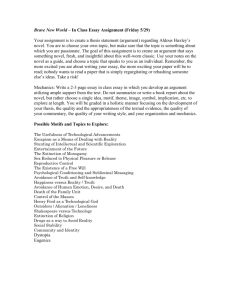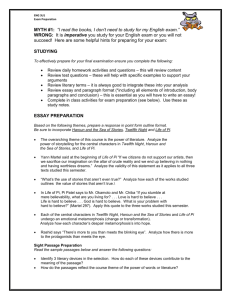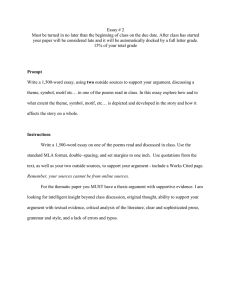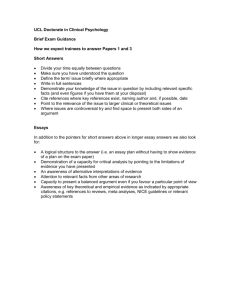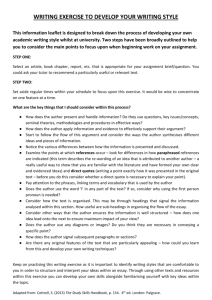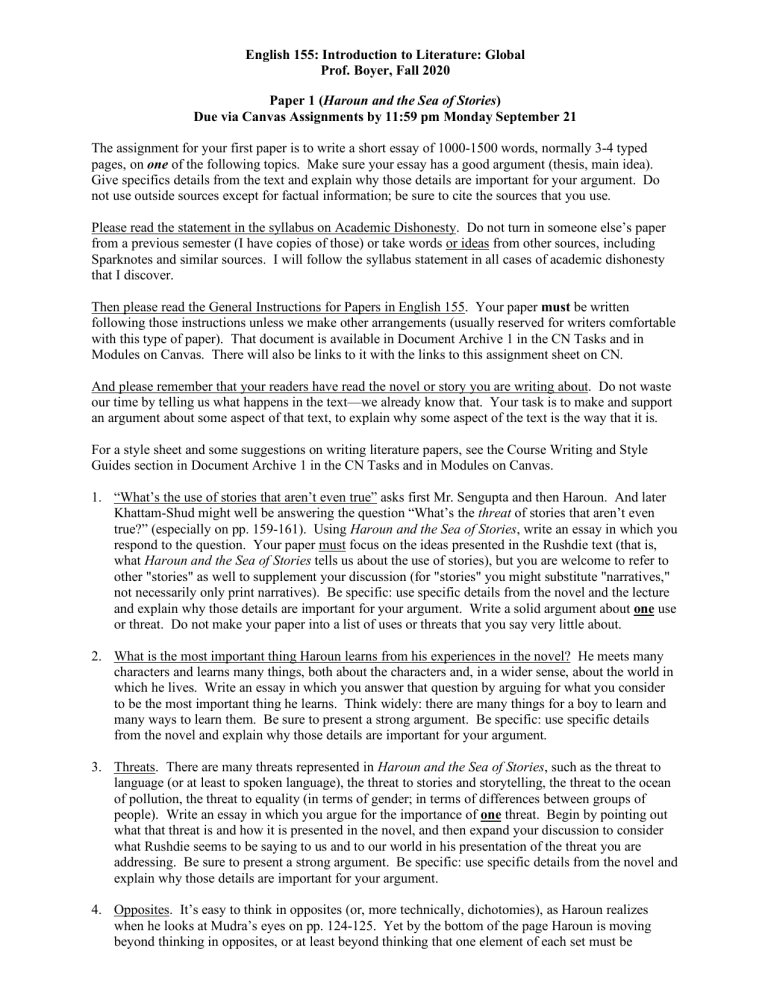
English 155: Introduction to Literature: Global Prof. Boyer, Fall 2020 Paper 1 (Haroun and the Sea of Stories) Due via Canvas Assignments by 11:59 pm Monday September 21 The assignment for your first paper is to write a short essay of 1000-1500 words, normally 3-4 typed pages, on one of the following topics. Make sure your essay has a good argument (thesis, main idea). Give specifics details from the text and explain why those details are important for your argument. Do not use outside sources except for factual information; be sure to cite the sources that you use. Please read the statement in the syllabus on Academic Dishonesty. Do not turn in someone else’s paper from a previous semester (I have copies of those) or take words or ideas from other sources, including Sparknotes and similar sources. I will follow the syllabus statement in all cases of academic dishonesty that I discover. Then please read the General Instructions for Papers in English 155. Your paper must be written following those instructions unless we make other arrangements (usually reserved for writers comfortable with this type of paper). That document is available in Document Archive 1 in the CN Tasks and in Modules on Canvas. There will also be links to it with the links to this assignment sheet on CN. And please remember that your readers have read the novel or story you are writing about. Do not waste our time by telling us what happens in the text—we already know that. Your task is to make and support an argument about some aspect of that text, to explain why some aspect of the text is the way that it is. For a style sheet and some suggestions on writing literature papers, see the Course Writing and Style Guides section in Document Archive 1 in the CN Tasks and in Modules on Canvas. 1. “What’s the use of stories that aren’t even true” asks first Mr. Sengupta and then Haroun. And later Khattam-Shud might well be answering the question “What’s the threat of stories that aren’t even true?” (especially on pp. 159-161). Using Haroun and the Sea of Stories, write an essay in which you respond to the question. Your paper must focus on the ideas presented in the Rushdie text (that is, what Haroun and the Sea of Stories tells us about the use of stories), but you are welcome to refer to other "stories" as well to supplement your discussion (for "stories" you might substitute "narratives," not necessarily only print narratives). Be specific: use specific details from the novel and the lecture and explain why those details are important for your argument. Write a solid argument about one use or threat. Do not make your paper into a list of uses or threats that you say very little about. 2. What is the most important thing Haroun learns from his experiences in the novel? He meets many characters and learns many things, both about the characters and, in a wider sense, about the world in which he lives. Write an essay in which you answer that question by arguing for what you consider to be the most important thing he learns. Think widely: there are many things for a boy to learn and many ways to learn them. Be sure to present a strong argument. Be specific: use specific details from the novel and explain why those details are important for your argument. 3. Threats. There are many threats represented in Haroun and the Sea of Stories, such as the threat to language (or at least to spoken language), the threat to stories and storytelling, the threat to the ocean of pollution, the threat to equality (in terms of gender; in terms of differences between groups of people). Write an essay in which you argue for the importance of one threat. Begin by pointing out what that threat is and how it is presented in the novel, and then expand your discussion to consider what Rushdie seems to be saying to us and to our world in his presentation of the threat you are addressing. Be sure to present a strong argument. Be specific: use specific details from the novel and explain why those details are important for your argument. 4. Opposites. It’s easy to think in opposites (or, more technically, dichotomies), as Haroun realizes when he looks at Mudra’s eyes on pp. 124-125. Yet by the bottom of the page Haroun is moving beyond thinking in opposites, or at least beyond thinking that one element of each set must be positive and the other negative. This seems to me, and perhaps to you, to be one of the most important moments in the novel in terms of the ideas the novel develops. So write an essay about it. Start from this passage and look closely at one way in which this idea is developed in the novel. Your argument should focus on the importance of the way you have chosen and on what Rushdie seems to want us to make of it. Be sure to present a strong argument. Be specific: use specific details from the novel and the lecture and explain why those details are important for your argument. 5. Haroun and the Sea of Stories as narrative. Think about the novel in terms of the essay by Delistraty we read in the first week. How do what Delistraty says affect your understanding of the Haroun and the Sea of Stories as narrative? Write an essay in which you argue in these terms. How can Delistraty help us to understand the way the novel works as a narrative? Be sure to present a strong argument. Be specific: use specific details from the novel and the lecture and explain why those details are important for your argument. 6. The happy ending. In the end, Haroun gets the happy ending he undoubtedly wants. But it’s not that easy. How do you respond to the ending? the most important elements I see are the Walrus granting Haroun a (rare) happy ending, the changing tone in Haroun’s city, and the return of his mother. Write an essay about this happy ending. How does it work? Does it need the Walrus’s intervention? What is Rushdie saying about the ability of fiction to provide the (artificial?) happy endings that we seem to long for? Does the essay we read by Delistraty help to explain the nature of this happy ending? (See topic 5.). Be sure to present a strong argument. Be specific: use specific details from the novel and explain why those details are important for your argument. Themes and Motifs 7. Themes and motifs. Haroun and the Sea of Stories makes use of many themes and motifs. (For a definition of the terms see the “Theme and Motif” document in Document Archive 1 in Tasks on CN and in Modules on Canvas.) Some of those themes are identified by Isabel Allende on the cover of The Kite Runner as “love, honor, guilt, fear, redemption.” And there are more. Write an essay on one theme or motif that you find in Haroun and the Sea of Stories. Begin by identifying the theme or motif and explaining its use in the novel. Then show in greater detail how it is used in that text and consider how it relates to the text as a whole. Please remember that a work of literature is much more likely to be putting a particular theme “on the table” for discussion and then presenting different aspects of the theme for the readers’ consideration. Good works of literature normally do not tell you what the theme “means” but asks you to look at the many things in could mean in that particular work. Be sure to present a strong argument supporting your understanding of how the theme or motif works in the text. Be specific: use specific details from the text and explain why those details are important for your argument. Your Own Topic 8. Your own topic. You are welcome to develop a different topic related to Haroun and the Sea of Stories. Be sure to develop a strong argument for an important point about one thing (one character, one idea, and so forth). Be specific: use specific details from the text and explain why those details are important for your argument. Please check the topic with be before you begin writing, preferably by email.
